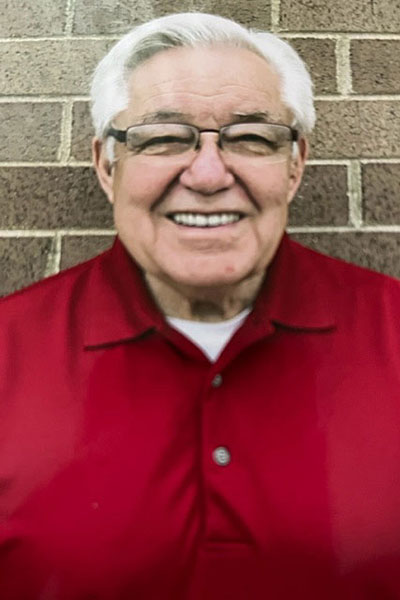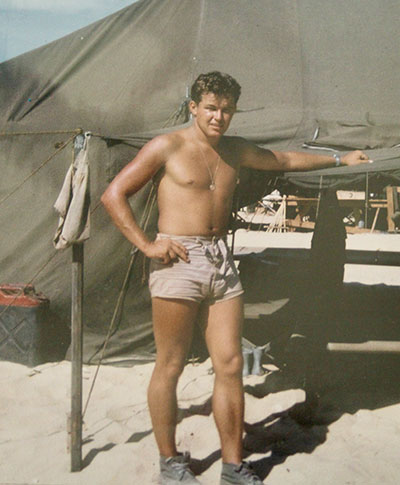Navy Vietnam War Elgin, IL Flight date: 04/13/22
By David Adams, Honor Flight Chicago Veteran Interview Volunteer
William “Bill” Baker grew up probably as far from the sea as one could in the States. Born in Minneapolis on January 5, 1940, he lived in Maple Lake just north and west of the Twin Cities, surrounded by farm country. Bill’s grandfather owned a 740 acre farm, the largest in the county, where Bill, the eldest of five, learned threshing and hay bailing at an early age. He excelled in sports at Maple Lake High School, graduating in 1958 with sixteen letters, four each in football, basketball, track, and baseball.
Bill attended two years at St. John’s University, Collegeville, Minnesota before the money he had earned for college ran out. While working to refill his bank account, Uncle Sam came calling with a draft notice. He interviewed with the Navy, Marines and Air Force before he found a fit with the Navy instead of the Army. Bill remarks that each service wanted him.
Entering the Navy on January 10, 1962, he first attended Basic Training in San Diego. After a rigorous four weeks of Basic, he was one of thirty in his class selected to attend UDT (Underwater Demolition Team) school at Naval Amphibious Base Coronado. An additional 87 sailors swelled the class to 117. Following four months of intensive demolition and scuba dive training, just 33 graduated in his UDT Class 28. Bill remembers that much of the dive training, conducted in teams of two, was at night. In particular he recalls encountering phosphorescent fish during some dives. When startled, an individual fish would light up, triggering others in the vicinity to do the same. These encounters in turn unnerved the divers. Candidates also attended and completed jump training at Fort Benning where Bill earned his jump wings. By the beginning of August 1962, Bill was a fully qualified Underwater Demolition Team combative swimmer. He was able to conduct underwater search, surveillance, ship attack and beach reconnaissance including cartography. He also learned to conduct naval special warfare operations. Finally, he could perform parachuting as an essential portion of appropriate assigned duties and was fully qualified in the operational use of all types of SCUBA. Whew, that’s a lot of skills!
Upon graduation, he was assigned to Team 12, or UDT-12. The team, consisting of fifty enlisted men and officers, made periodic six-month deployments overseas. Its “home base” was Subic Bay Naval Base in the Philippines. From there it conducted advanced training in Japan and Taiwan, and combat operations in South Vietnam. From 1963 -1965 he deployed three times (the first two consecutive), spending the bulk of the time in-country at Chu Lai, South Vietnam located about 70 miles south of Da Nang. At Chu Lai, he and his team were tasked with “building up” naval forces and equipment. Bill says he spent most of his time “on the beach.” The team’s compound was very near the unit hospital, a convenient location in case of injury or wounds. He is forever grateful that the Viet Cong did not attack Chu Lai during any of his deployments. Bill served as lead cartographer for UDT-12. Cartographers surveyed the sea floor just offshore and prepared detailed hydrographic charts designed to portray what is safe for navigation. He remembers that he spent most of his time every day in the water. In the evening, he drew up the charts for the Navy so that its ships could safely bring men and materials ashore.
The team’s own ship was the destroyer escort USS Diachenko on which they traveled and from which they trained. Bill recalls that UDT-12 was tasked to dispose of about 600 tons of 20-year-old WWII ammo stored below decks of the ship in its magazine. Not expecting the ammo to explode, the team, as experts in demolition, blew the ammo up in Subic Bay to everyone’s surprise. Bill says, “There were barracuda floating to the surface for days.”


Bill remarks that UDT-12 was instrumental in paving the way for the Marines to “bring a lot of stuff ashore” during Operation Starlite at a location south of Chu Lai. This operation, conducted from August 18-24, 1965, involved the first offensive operation of purely United States forces against the Viet Cong. After action reports reveal that in excess of 5,000 Marines and sailors came ashore during the Op. Bill and UDT-12 also worked with swimmer delivery vehicles (SDV) which could be deployed from submarines. He was involved in validating the viability and safety of SDVs. This was cutting edge technology and proved essential to SEAL Operations going forward.
His last assignment, which extended his four-year enlistment by several months, was related to the Gemini Space Program. Bill joined a five member team to develop a training program for UDT teams supporting recovery of Gemini capsules worldwide. He did not complain about being stationed in Hawaii for this his final assignment. Bill describes his return to the States after service in Vietnam as a “no hip hip hooray” event.
During his more than 4 years in the Navy, he deployed to Southeast Asia three times and overall spent more than 3 years and 9 months overseas or at sea. Bill was honorably discharged on May 9, 1966 with these awards: Good Conduct Medal, Basic Parachutist Insignia, Vietnam Service Medal, and Expert Pistol Shot Medal.
He returned to Minnesota where he enrolled at St. Cloud State University to complete his college degree with the help of the GI Bill. Bill graduated in 1968 with a Bachelor of Arts degree majoring in marketing and management. Bill met his soon-to-be wife Karen on a blind date in 1968. She had been her high school Homecoming Queen and may not have been really surprised that Bill was Homecoming King at his school. This royal couple married a year later.
Bill’s first employer was Target, headquartered in Minneapolis, a fledgling company at the time with only four stores. Working in human resources, he became heavily involved in the corporation’s community service programs, particularly the United Way. Community service has been central to Bill’s life ever since. He remained in human resources rising to the highest executive levels. His most gratifying work was as HR manager for Grand Casinos which is domiciled in Minneapolis. Bill recalls working in its Mississippi Delta location and extending the company’s resources into many local communities. He retired in 2010 from Caesars Entertainment as its HR director.
Bill and Karen celebrated their 53rd wedding anniversary on February 1. They have two daughters and four grandchildren, three boys and a girl. After the ubiquitous two-year “pandemic pause,” they plan to return to ocean cruising. Bill confesses that, given the chance, he would cruise to Antarctica to see penguins and other fauna, then continue the voyage to Buenos Aires where he would show off his tango skills. His most compelling memory of his service: “I went into the Navy as one Bill and came out a different Bill!”
Thank you, Bill, for your courageous and distinguished service. Enjoy your special day of honor in Washington D.C. with your comrades in arms. This will surely be a “Hip hip hooray” welcome home!


